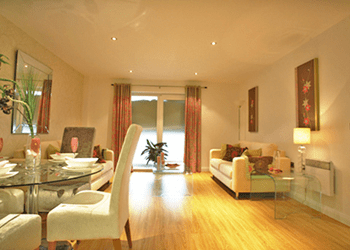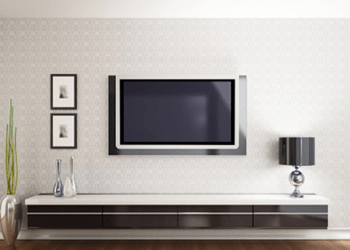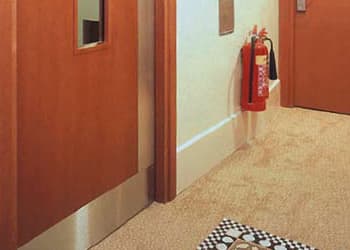Acoustic Requirements of Building Regulations:
Approved Document Part E 2003 (England and Wales)
What does Part E cover?
This document, which took effect on July 1st 2003, aims to improve standards of sound insulation in buildings, between homes or in rooms used for residential purposes. It is designed to meet the demands for improved acoustic insulation and combat the problems of noise pollution from noisy neighbours.
These new regulations, unlike previous requirements, apply to both new build and refurbishment or conversion projects on all types of dwellings including, flats and apartments, semi detached and terraced housing, hotels, hostels, nursing homes and student accommodation. It applies to the separating walls, floors and ceilings between different dwellings only and not to those within the same dwelling.
One of the main differences of the new regulations is how airborne performance is now measured. A spectrum adaptation term (Ctr) is now applied, which puts a much greater emphasis on low frequency sound (100Hz to 315Hz). These low frequencies are the cause of much modern noise pollution but are also among the most difficult to combat.
The document outlines the methods of compliance and distinguishes between new build and material change of use projects, stating the different requirements for each.
Approved Document E requires protection against sound in dwelling houses, flats, rooms for residential purposes and schools. The document comprises four parts:
Part E 1 – Provides protection against sound from separating walls and floors from other parts of the same building and adjoining buildings.
Part E 2 – Provides protection against sound internally within a dwelling-house, for example internal walls between a bedroom or a room containing a water closet and other rooms, and internal floors.
Part E 3 – Provides protection against reverberation sound in the common internal parts of buildings containing flats or rooms for residential purposes.
Part E 4 – Provides protection against sound in schools.
Performance standards for separating walls, separating floors and stairs that have a separating function in dwelling-houses and flats
| New Build |
Airborne Sound Insulation (DnT,w Ctr dB minimum values) |
Impact Sound Insulation (L’nT,w dB maximum values) |
| Walls | 45 | |
| Floors & Stairs | 45 | 62 |
| Conversions (Material Change of Use) | ||
| Walls | 43 | |
| Floors & Stairs | 43 | 64 |
Performance standards for separating walls, floors and stairs in rooms for residential purposes (hotels, hostels, boarding houses, halls of residence or residential homes)
| New Build |
Airborne Sound Insulation (DnT,w Ctr dB minimum values) |
Impact Sound Insulation (L’nT,w dB maximum values) |
| Walls | 43 | |
| Floors & Stairs | 45 | 62 |
| Conversions (Material Change of Use) | ||
| Walls | 43 | |
| Floors & Stairs | 43 | 64 |
Laboratory values for new internal walls and floors within dwelling-houses, flats and rooms for residential purposes, whether purpose built or formed by material change of use.
| New Build & Conversions |
Airborne Sound Insulation (DnT,w Ctr dB minimum values) |
| Walls | 40 |
| Floors & Stairs | 40 |
Methods of compliance
Compliance with Approved Document E is via two methods: Pre-Completion Testing or site registration with Robust Details Ltd.
Pre-Completion Testing
Part E states that 10% of all units constructed on a project must be pre-completion sound tested (PCT) on site. The separating walls and floors within each unit must be tested to show compliance. This applies to rooms used for residential purposes, houses and flats generated by the conversion of other buildings and new build houses and flats. The separating walls between flats and the communal areas do not require a sound test
The required insulation values are set out in the tables and apply to rooms that are completed but not furnished or occupied and that also separate spaces used for domestic purposes.
An accredited acoustician (ANC, UKAS) must carry out the tests to show compliance with the relevant performance standards in accordance with:
BS EN ISO 140-4: 1998 (airborne)
BS EN ISO 140-7: 1998 (impact)
A copy of the results must then be given to an approved inspector at Building Control.
Robust Details
Since July 1st, 2004, Robust Details have been allowed as an acceptable alternative to Pre-Completion Testing. Robust Details meet high performance standards and where they apply to separating wall and floor constructions, they avoid the need for Pre-Completion Testing. They will be accepted by Building Control bodies in England and Wales to confirm the properties are exempt from PCT, provided the Robust Details constructions have been correctly installed.
For more information visit www.robustdetails.com
Supporting your acoustic needs
When noise is a problem, a wide choice of JCW Acoustic Supplies products can offer the right acoustic solution. Constant noise is frustrating, tiring and upsetting, so it’s important to restore the peace and quiet to a living area or workspace.
Peace of mind
Our products are easy to install and come complete with full installation guides. Next day delivery, wherever you are in the UK, is part of our service promise. We will also advise you on which products you need and how to ensure you meet all the legal requirements of Building Regulations.
Sustainability
JCW Acoustic Supplies is committed to caring for the environment and recycles materials wherever possible. All JCW Acoustic Supplies timber products have FSC accreditation, meaning they are bought from a sustainable, traceable source.
Acoustic Requirements Section 5 (Scotland)
Section 5 of the Scottish Technical handbooks (formerly known as Part H) deals with the reduction of sound through separating building elements located between domestic buildings.
The purpose of Section 5 is to protect the residents of a dwelling from noise in other areas of the same building or an attached building.
Performance standards requirements
| Airbourne sound insulation |
Mean value (DnT,w dB) minimum |
Individual value (DnT,w dB) minimum |
| Walls | 53 | 49 |
| Floors | 52 | 48 |
| Impact sound insulation |
Mean value (L’nTw dB) maximum |
Individual value (L’nTw dB) maximum |
| Floors | 61 | 65 |
Methods of compliance
Compliance to Section 5 can be shown by adherence to Specified Constructions or Performance Testing.
Specified Constructions
These are standard constructions that are listed in Section 5 of the Scottish Technical handbooks. Remember these solutions are for guidance only, so it is possible that building control managers could also request a Performance Test.
Performance Testing
Performance Testing will be required when the construction has not been built to Specified Constructions or if the building control manager has requested a Post Completion test
Performance Testing is carried out after the build using UKAS approved testing equipment. Remedial action must be taken if a building element fails this test.
Sound insulation testing to show compliance with the relevant performance standards should be conducted in accordance with:
BS EN ISO 140-4: 1998 (airborne)
BS EN ISO 140-7: 1998 (impact)




